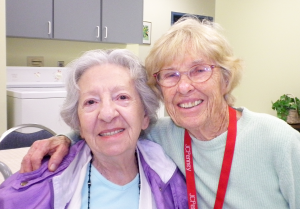Did you know?
- At least 10 million people are blind in the US today, according to American Foundation for the Blind.
- In Florida, the incidence is 10 per 1,000 individuals, or twice the national rate according to the National Eye Institute.
- There are an estimated 24,014 individuals who are visually impaired and blind living in the counties we serve (Citrus 5,730; Hernando 5,559; Pasco 12,725).
- Vision loss impacts all areas of life, including employment. The unemployment rate among working aged Americans with vision impairment is 70%.
What are some signs of a possible vision loss?
- Discontinuing activities that were once enjoyed such as talking on the phone, going to movies, or needlepoint
- Difficulty interacting in group settings, like parties or meetings
- No longer watching television
- Moving away from strong lights and windows, or difficulty seeing in dimly lit rooms
- Tripping or knocking over things at home, or walking as though dizzy or unbalanced
- Touching people to get their attention
- Over cautious driving habits
- Frequent changes to eye glass prescriptions
- Holding books or reading material close to face or at arm’s length
- Squinting or tilting the head to see
- Difficulty recognizing people
- Change in personal appearance and/or changes in table etiquette
- Moving about cautiously
- Acting confused or disoriented
What is vision rehabilitation?
- Vision Rehabilitation is a specialized array of services and training which enable people who are blind or experiencing significant vision loss to participate fully in home life, education, community activities and employment.
- Vision Rehabilitation Services reduce the economic and human cost of blindness. Outcomes of these essential services include reduced unemployment, reduced admissions to Assisted Living Facilities and Nursing Homes, reduced emergency room admissions, and increased economic productivity for family members who no longer need to provide home care for loved ones who have lost vision.
- The Lighthouse utilizes a curriculum of methods and techniques based on the Vision Rehabilitation Model for developing independent living skills, orientation and mobility skills, and the use of adaptive technology/devices. The curriculum/programs are based on best practice in the field of Vision Rehabilitation.
What is significant vision loss?
Individuals who meet at least one of the following criteria are considered to have significant vision loss: 1) Visual acuity of 20/50 or worse in the better eye that cannot be corrected by optical lenses, 2) The visual field is less than 20 degrees in diameter (tunnel vision), 3) Regular print cannot be read using reading glasses, 4) Obstructions in the visual field (floaters) or ‘blind spots’ significantly impact the ability to perform skills of daily living, 5) A diagnosis of continued vision loss is determined by an Ophthalmologist.
Need more information?
Learn about ways you can help.
Learn how vision rehabilitation has helped our clients regain their independence.
